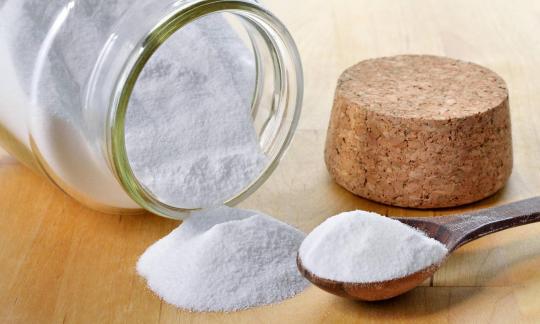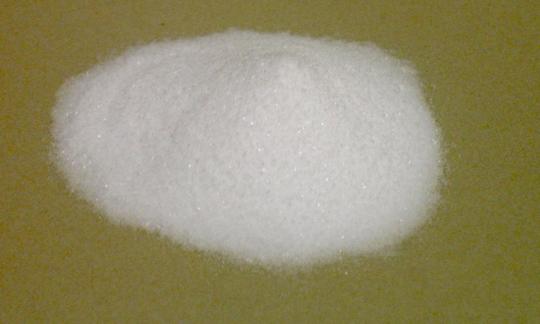Table of contents
Baking soda or sodium bicarbonate is the sodium salt of carbonic acid with the formula NaHCO 3 . In addition to its role as a popular baking agent in the kitchen, it has numerous other uses. There is no difference between conventional and organic baking soda, as it is a mineral product.
Use in the kitchen
Baking soda is a popular leavening agent in the kitchen, used in dough products such as cakes (e.g. vegan, flourless brownies ), cookies and muffins . To get the dough going, you need an acidifier such as vinegar or lemon juice . This combination produces carbon dioxide gas, which makes the dough rise and gives it an airy texture. In the commercial sector, it is mainly used to make baking powder and effervescent powder.
The white crystalline powder is great for fluffing up vegan pancakes or omelettes. Baking soda in cooking water also prevents vegetables or fruit from bleaching. Add a pinch of baking soda to cooked peas , green beans or corn and the color will stay the same.
Baking soda also helps you cook pulses such as chickpeas , mung beans or kidney beans more quickly. Adding 1 teaspoon of baking soda per liter shortens the cooking time. The baking soda water used should always be thrown away.
Baking soda is highly basic (alkaline). It can be used in dishes to neutralize excess acid. In addition to sour-tasting vegetables, e.g. tomatoes or rhubarb (oxalic acid), it also balances the taste of very sour fruits with other fruit acids, such as red currants or gooseberries . The processed fruits (e.g. fruit juice) have a much milder taste at around ½ teaspoon/kg and you can reduce the sugar somewhat. This effect also helps to neutralize added acids, such as vinegar or lemon juice.
In addition, tomatoes and carrots are much easier to peel with 1-2 teaspoons of baking soda per liter of blanching water. Mashed potatoes get a creamy, tender consistency with a teaspoon of baking soda per kg of potatoes .
Adding a pinch of baking soda to coffee helps reduce bitterness and add flavor. It is also useful for cleaning fruits and vegetables.
Raising agents - differences
What is the difference between baking soda and baking powder? Baking soda is pure sodium hydrogen carbonate. Baking powder consists of a CO 2 source (the baking soda), an acidifier (disodium dihydrogen diphosphate E 450a, tartaric acid or calcium dihydrogen phosphate E 341a as acid carrier) and a release agent. The release agent is starch (e.g. corn starch ), which prevents the CO 2 source from reacting too early. In combination with moisture and heat, gaseous carbon dioxide is produced: small gas bubbles form, which loosen the dough and increase its volume.
Baking powder and baking soda are particularly suitable for quickly mixed batter. Flat shortcrust pastries (cake bases, biscuits) rarely contain baking powder. In yeast dough, the yeast itself takes on the role of the raising agent. For flat long-lasting baked goods, pure ammonium bicarbonate can be used. Potassium carbonate (potash), ammonium bicarbonate (ABC raising agent, E 503) or a mixture of ammonium bicarbonate and ammonium carbamate (1:1) is also suitable for gingerbread or honey cake. The ammonia contained in it decomposes at temperatures of 60 °C. However, baking with ammonium bicarbonate promotes the formation of acrylamide (Maillard reaction).
Cream of tartar baking powder has the same effect as "normal" baking powder, except that the acid is phosphate-free and comes from natural cream of tartar (potassium hydrogen tartrate), e.g. from sparkling wine production.
With baking yeast ( Saccharomyces cerevisiae ), a distinction is made between fresh baking yeast (pressed yeast, baker's yeast) and baking yeast as active dry yeast . Fresh yeast has a stronger leavening power, but requires longer rising times and several rest phases. Dry yeast works without stirring the dough. In addition to being used as a natural raising agent, yeast fungi are used as food supplements or seasonings due to their high content of glutamic acid and B vitamins - as is the case with yeast flakes (noble yeast ). However, as noble yeast is an inactive form of yeast, it can no longer be used for baking. Highly concentrated and as a spread, these fungi can also be found in the form of yeast-based spice pastes - a very intensely flavored yeast extract made from lysed yeast cells (produced by the destruction of cell walls).
Brewer's yeast , originally used in beer production, straddles the line between a raising agent, dietary supplement, cosmetic product and probiotic - depending on the processing (active, inactivated, etc.) in which it is consumed.
In addition to yeast, sourdough also contains lactic acid bacteria. The rising times are somewhat longer and the taste (including that of the end product) is significantly more sour. Baking ferment is also common among organic bakers. This sourdough consists of wheat , peas and honey and is available in granulated form.
Vegan recipe for spelt pretzels
Ingredients: 150 g spelt flour , 100 g wholemeal spelt flour , 50 g finely ground linseed (linseed flour), 7 gdry yeast , 250 ml oat milk , 20 ml rapeseed oil , 1 teaspoon salt, 2 tablespoons honey , 1.5 l water , 2 tablespoons baking soda and another 1 teaspoon salt.
Preparation: To make the dough, warm the milk slightly and add the honey and dry yeast. For a vegan version, Agave syrup or cane sugar . After 10 minutes, add spelt flour, linseed, oil and salt and knead the mixture with a kneading machine or by hand to form a smooth dough. Leave the dough to rest for 30 minutes and then shape it into pretzels. Pretzels are made in a lye with baking soda. You will need a large pot with 1.5 litres of water, baking soda and salt. Before baking, place the formed pretzels in the simmering baking soda water for around 30 seconds (using a slotted spoon). You can sprinkle the pretzels with coarse salt, sesame or poppy seeds. Then finish baking the pretzels in the oven at 180 °C for around 15-20 minutes.
Vegan recipe for chocolate cake
Ingredients: 170 g wheat flour , 40 g unsweetened cocoa powder , 180 g pitted dates , 1 teaspoon baking soda, 1 pinch of salt , 250 ml water , 1 vanilla pod , 80 g apple sauce , 80 g ground walnuts or almonds , 1 teaspoon apple cider vinegar , 1 tablespoon oil (e.g. rapeseed oil ) for the mold.
Preparation: Preheat the oven to 180 °C top/bottom heat and grease a cake tin (e.g. loaf tin) with oil. Mix the sugar, bourbon vanilla pulp, salt, oil, vinegar and water well with a hand mixer or food processor. Mix the cocoa powder, baking soda and flour and carefully fold into the mixture. Pour the cake batter into the tin and bake in the oven for approx. 40 minutes. Once cool, remove the chocolate cake from the tin and cut into pieces.
Vegan recipes with baking soda can be found under the note: " Recipes that have the most of this ingredient ".
| Not only vegans or vegetarians should read this: Vegans often eat unhealthily. Avoidable nutritional mistakes . |
Purchasing - Storage
Baking soda is available at all supermarket chains such as Coop , Migros , Denner , Volg , Spar , Aldi , Lidl , Rewe , Edeka , Hofer , Billa , etc., usually in the baking department in 5-7 g portion bags. Sometimes there are also packaging sizes of 20, 50 or 100 g. You can get even larger quantities in drugstores, pharmacies or online. Baking soda can also be found in organic supermarkets such as Denn's Biomarkt and Alnatura .
Like other chemical substances, baking soda is available in various purity levels specified by the European Pharmacopoeia . These differ in their quality requirements depending on the intended use. The lowest level is technical quality, followed by food, pharmaceutical and analytical quality. Pharmaceutical quality is purer than food quality. Chemical substances should always be at least food quality for safe oral consumption. When buying baking soda, especially online products, pay attention to the purity level!
The availability of baking soda varies depending on the size of the store, catchment area, etc. You can find our recorded food prices for the DA-CH countries above under the ingredient image - and by clicking you can see their development at different suppliers.
Storage tips
Sodium hydrogen carbonate should be stored in a cool place (approx. 6-25 °C), dry and protected from light, so it has a shelf life of 24 months. It is important to keep it out of the reach of children.
Ingredients - Nutritional values - Calories
Baking soda contains no proteins, fats, carbohydrates or fiber and therefore has no significant calories. It naturally contains a particularly high amount of sodium : with 273.6 mg, 1 g of baking soda covers around 34% of the daily sodium requirement. Only sea salt and table salt have a higher sodium content, with over 380 mg/1g. Apart from that, there are traces of selenium in baking soda among the micronutrients. 1
Typically, baking soda is consumed in such small amounts that it has no significant effect on nutrient absorption.
You can find all the ingredients of baking soda, how much it covers your daily needs and comparison values with other ingredients in our nutrient tables below the ingredient image.
Effects on health
Basic research indicates that a change in pH can influence the growth and metastasis of tumor cells. 2,3,4 This theory is based on the idea that cancer cells grow in an acidic environment and an increase in pH can possibly inhibit the growth of cancer cells. However, according to the German Cancer Research Center ( DKFZ ), caution should be taken with claims that sodium bicarbonate helps against cancer, as this method has not yet been proven to be effective. In addition, excessive consumption is associated with side effects. 5
In addition to the neutralizing effect on stomach acid, baking soda is also said to help with inflammation. Regular oral intake (diluted with water) can increase the number of macrophages (M2) in the spleen. Macrophages are important cells of the innate immune system that have an anti-inflammatory effect. 6
This study also shows that daily consumption of baking soda water can reduce kidney-related hyperacidity and also slow down the progression of kidney disease and kidney failure. The effect is related to the increase in anti-inflammatory macrophages (M2). 6 The research results suggest that baking soda could potentially play a promising role in the treatment of autoimmune diseases in the future. Further studies are needed to better understand the relationships between the processes involved.
Baking soda is sometimes touted as an alkaline agent for "deacidifying the body." However, it is better to regulate the acid-base balance through diet rather than taking "alkaline powder." The body regulates the pH value of the blood so that it is in a range between 7.35 and 7.45 (adults). 10 Increased consumption of animal proteins, e.g. through the consumption of cheese, meat and fish, leads to an increase in blood acidity, which can lead to chronic mild metabolic acidosis (hyperacidity). 25,26 The body must excrete the extra acid, which occurs via the intestines, kidneys and breath. In the long term, this can lead to kidney damage and urinary stones. 24,25 In contrast, a plant-based diet with (especially raw) fruit and vegetables helps to keep the acid load in the body low. One study shows that following a vegan diet for seven days not only increased 24-hour urine pH but also reduced cholesterol absorption and increased fiber intake, which are beneficial for health. 26 Consuming animal products also has a negative impact on bone health. 9
In healthy, physically active people without malnutrition, the use of baking soda (in the right dosage) can have a potentially performance-enhancing effect. 7 The duration of training is an important factor here, but the exact relationships are still unclear. One study examined the effects of acute or chronic dietary supplementation with NaHCO 3 on training performance of less or more than four minutes in trained athletes. Almost 50% of all randomized, controlled studies reported positive effects of dietary supplementation. However, the use of baking soda to improve performance in athletes is not recommended due to the lack of clear, consistent results. 8
In medicine, baking soda is used as an antidote for poisoning with barbiturates, salicylates and tricyclic antidepressants. 5,11 Baking soda can also provide relief for heartburn, but it can also cause side effects. More on this in the next chapter. Approved drugs such as antacids and proton pump inhibitors have proven to be more effective. 5
Secondary plant substances
Secondary plant substances are not relevant for baking soda. Find out more about the importance and classification of these bioactive substances in food in the article on secondary plant substances .
Dangers - Intolerances - Side effects
The recommendation to use baking soda for heartburn is outdated. Although it neutralizes stomach acid as an alkaline agent, the effect is only short-term and it should not be used too often. The sudden drop in acidity in the stomach can cause an acid rebound (increased acid production) and the symptoms of heartburn can become worse as a result. 12
In addition, if the dose is too high, sodium bicarbonate can cause nausea, vomiting, diarrhea, muscle weakness and cramps, as the formation of CO 2 leads to increased belching. 5,12 Kidney stones and high blood pressure rarely occur.
Interactions with other medications are also to be expected. The alkaline pH value of baking soda can affect the effectiveness of sympathomimetics, barbiturates, H 2 receptor blockers, glucocorticoids and diuretics. If you still want to take baking soda, you should leave a gap of at least 1-2 hours between taking it and other medications. Clinical studies with cancer patients are still lacking to provide meaningful results. 5
It should be noted that the interactions and side effects only apply to increased consumption of unprocessed (or only dissolved in water) baking soda. Baking soda breaks down into carbon dioxide at high temperatures during baking. There is therefore no reason to worry when consuming baked goods. 5
Folk medicine - natural healing
As a household remedy, baking soda is also used for personal hygiene. It is traditionally used as a shampoo alternative, mouthwash, for hair lightening and in toothpaste. You can make your own deodorants from sodium bicarbonate, as it neutralizes the odorous fatty acids that are produced by the action of bacteria on sweat. Baking soda is also used as an oral hygiene product: It is used, among other things, to prevent tooth decay, for periodontitis, bad breath, tooth erosion, oral cancer, in dental care products and to remove discoloration and plaque. 13
Externally, baking soda moisturizes and softens dry skin. It is also said to help with athlete's foot, psoriasis, acne and eczema. 14
Ecological footprint - animal welfare
According to Carbon Cloud, the ecological footprint of baking soda is 1.4 kg CO 2 eq/kg. 15 Despite extensive research, we were unable to find any information from other sources. The ecological footprint should therefore be viewed with caution, as we do not have any comparative values. However, the value seems realistic when compared with that of sodium carbonate. The Federal Office for Economic Affairs and Export Control ( BAFA ) gives a CO 2 footprint of 1.25 CO 2 eq/kg. 16
The source of the soda has a decisive influence on the ecological footprint. When producing soda, the Solvay process produces soda as a by-product. However, this production process raises some environmental concerns as it is very energy-intensive. Burning the lime requires a lot of energy. The production process also involves the release of carbon dioxide. However, a large proportion of the CO 2 produced can be recycled into the process. The Solvay process is not considered environmentally friendly in terms of CO 2 emissions as CO 2 is released again in the subsequent steps of the process. 17,23 In addition, waste products (including calcium chloride) are produced, the improper disposal of which can result in environmental pollution: the waste usually ends up in rivers, lakes or the sea. 18,23
Unfortunately, we do not have any precise information on the water footprint of baking soda. But it is known that the Solvay process requires large amounts of water.
Detailed explanations of various sustainability indicators (such as ecological footprint, CO2 footprint, water footprint) can be found here .
In agriculture, baking soda can help minimize the release of harmful chemical pesticides. Studies show that it is effective as an environmentally friendly fungicide in controlling fungal infections in crops.19 Using baking soda reduces the release of harmful chemicals into the environment, promoting organic farming and thus contributing to biodiversity.
Sodium bicarbonate can be used to absorb acidic pollutants from the flue gases of industrial plants, such as waste incinerators or coal-fired power plants. By reducing harmful emissions, it helps improve air quality and helps combat acid rain. 20,22
In addition, baking soda is a sustainable alternative to chemical cleaning agents. See the chapter "Other applications". Unlike conventional cleaning agents, it is non-toxic and biodegradable, which reduces the pollution of household wastewater. 21
Worldwide occurrence - cultivation
Sodium bicarbonate also occurs naturally. The mineral nahcolite is abundant in the United States, particularly in Colorado, where it is mostly found in oil shale. It can therefore only be extracted as a byproduct of oil production. 22
Industrial production
Except in the USA, there are no known natural deposits from which soda can be extracted for industrial use. For commercial purposes, soda is therefore produced from the mineral Trona or using the Solvay process.
The Solvay process is based on a synthetic reaction in which sodium chloride, ammonia and carbon dioxide react with each other in water to produce sodium bicarbonate. 23
Simplified, the following reaction results in the formation of sodium bicarbonate: 23
NaCl + CO 2 + 2 H 2 O + NH 3 > NaHCO 3 + NH 4 Cl
Further information
Sodium bicarbonate has the chemical formula NaHCO 3 and is a hydrogen carbonates. It is a sodium salt of carbonic acid that is colorless .
At temperatures above 50 °C, the crystalline solid decomposes and breaks down into sodium carbonate (soda), water and carbon dioxide. The chemical reaction of thermal decomposition is:
2 NaHCO 3 > Na 2 CO 3 + CO 2 + H 2 O
When baking soda is mixed with an acid, a neutralization reaction takes place, producing water, carbon dioxide and salt:
NaHCO 3 + HCl > NaCl + CO 2 + 2 H 2 O
The carbon dioxide gas produced during this reaction is responsible for the dough rising and having a light texture.
hydrogen
Sodium carbonate is often confused with sodium carbonate, which is also known as soda. It has the molecular formula Na 2 CO 3 .
Bakers use caustic soda, i.e. sodium hydroxide (NaOH) dissolved in water, to make pretzels, a highly corrosive chemical. It is also called baker's lye, pretzel lye or caustic soda. It is used by dissolving lye pearls in cold water (never boil!). Safety regulations (chemical-resistant gloves and safety goggles) must be observed and it must be disposed of in a special way. When making lye (for e.g. pretzels) with baking soda, boiling water is used; there is no risk of chemical burns and it is also disposed of via the normal sewage system. The difference can be seen in the taste of the pastry, however.
Alternative names
for sodium bicarbonate include sodium bicarbonate (NaBi), but these terms are outdated. The names Bullrich's salt and Nabic are also no longer in use.
In the food industry it is known as E 500, where it is used as a raising agent and acidity regulator. E 500 also contains sodium carbonate and sodium sesquicarbonate.
However, it has other names in the trade, such as baking soda, baking soda, baking soda or baking soda; Kaiser-Natron is a brand name. The names with "soda" often lead to confusion.
In English, soda is known as sodium bicarbonate, sodium hydrogen carbonate or colloquially as baking soda or bicarbonate of soda.
Other uses
In the home, baking soda is ideal for cleaning, especially in combination with vinegar and citric acid. Baking soda can replace many cleaning products as dishwashing liquid, drain cleaner, toilet cleaner, oven cleaner or for removing limescale deposits. Because baking soda absorbs odors, it can be used to neutralize odors in cars, refrigerators, textiles or shoes. You can also make your own detergent with baking soda and a few other ingredients.










Comments